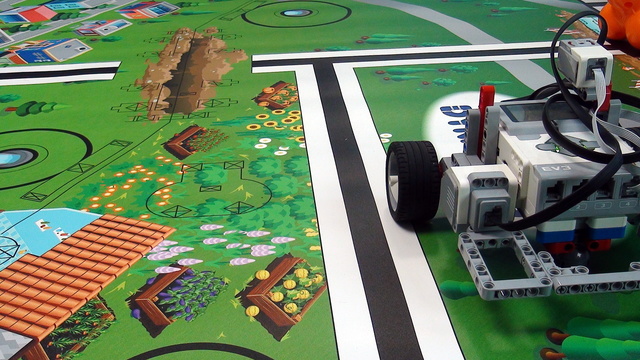DIfferent wheels and tires will result in different behaviour of the robot. That is actually pretty common sense. The real question is what is the influence. Would the robot make smaller deviations if it has smaller wheels or it will make larger deviations? The tires could also be quite dirty or brand new. Or the wheels could be attached in different ways.
- #649
- 09 Jan 2018
- 4:36
In this video tutorial, I would like to do a few experiments and try to find out what is the influence of the wheels and tires on the robot movement. It will not be a fully scientifically backup experiment, because we will do only a few tries, but you can continue it at home or school following the same principal.
Size of the wheels
Generally, the smaller the wheels the more precise and predictable the robot is. But if they are very small then we have a very slow robot. So it is a matter of balance.
Dirt on the tires
We've seen this a lot. If the tire has some dirt this could greatly change the traction and from there the robot will move slightly to one side or it will stop in a strange way. The best thing that you could do is to implement a program where the behaviour does not depend on the dirt on the tires.
Attachment of the wheels
When attaching a wheel the axle should always be attached to at least two points. It should never be only on the motor, but also on a frame on one of the side.
Five Minute Bot
Building instructions for a LEGO Mindstorms EV3 Robot that we call the Five Minute Bot because it could be built in Five Minutes.
Note: If the robot is making inconsistent turns due to the floor, modify the castor wheel so it is placed further back in the construction. Thus the center of mass falls more over the tires and the turns are more consistent.
English
Different wheels and different tires will result in different behavior of the robot. That is actually pretty common sense. The real question here is: What is this influence? Would the robot make smaller deviations if it has smaller wheels for example like these? Or would it make a larger deviation from the straight line? The tires could also be quite dirty or they could be brand new or the wheels could be attached in different ways. All of these could have an influence of how your robot moves and whether it moves straight. So, let's do a couple of experiments in this video and check out how the robot behaves with the different wheels and with different tires. First, we have some wheels and tires that are strictly EV3. And you can find these wheels in the EV3 set. We have some other wheels that are NXT wheels and probably you'll have some of those. Or you can have other technic wheels but it will be too long for an experiment to do an experiment with all the wheels in the LEGO world. So, let's do an experiment with 3-4 different wheels and at least you'll know how. Then you can experiments with wheels that you have. Let's find out the different influence with the different wheels.
So, what would be our conclusion here? You saw the recordings. And it's important to understand that probably most of the time in most of the cases if you have smaller wheels, the robot will be more predictable and more stable. You saw the behavior with very large NXT wheels and it was moving very much to the left. So, if you have smaller wheels with smaller tires, probably the robot will behave in a much more predictable way. But, that's not always the case and you should experiment for your specific robot. So, the size of the wheels matters. And the other thing that's important is how you attach the two wheels. You'll see in the course the behavior of the Box Robot and you'll also see the behavior of the Five Minute Robot. What's interesting about the Five Minute Robot is that you have the axle and the wheel is attached to the axle and the axle is attached to the motor and the axle is attached only to the motor nowhere else. While in the Box Robot we have the wheel and the wheel is right here and we have the wheel and the axle of the wheel and I hope that you can see it right here
so, right here is the axle.
And this axle is attached to the frame of the robot. And because the axle is attached to the frame of the robot and to the motor, this makes the axle much more stable and the wheel moves in a much more predictable way. So, this is the other important thing. Not only the size of the wheel but whether the axle is attached on two places. So, you should always try to attach the axle of the wheels on two different places - on the frame and on the motor.
Courses and lessons with this Tutorial
This Tutorial is used in the following courses and lessons

Moving Straight with LEGO Mindstorms EV3 robots
One of the most controversial topics when it comes to LEGO Mindstorms robots is how to make them move in a straight line. This is a problem that has caused a lot of confusion among teachers, parents, rookie teams and students. The robot makes about 2-3 centimetres error for every meter, which is about an inch for every 3-4 feets. In this course, I would like to discuss the different ways in which you can improve the behaviour of the robot and how you could make it move in a straight line with the help of the LEGO Mindstorms EV3 Gyro Sensor.
- 24
- 102:09
- 3

Understanding the issues with moving straight
The balance of the construction of the robot has a great influence on how it will move. This is especially true if you would like to move in a straight line. If the robot is slightly heavier on the right it will move to the right. Here we have two robots - a Five Minute robot and a Box Robot and we will discuss the differences in the constructions and why the box robot is much better than the Five Minute even though it is using the same parts.
- 6
- 0
- 0
- 3d_rotation 2
